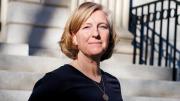Telling the broccoli story, even now, makes Usha Thakrar burn. It was nearly dark, she recalls, when a 53-foot tractor trailer packed with the fresh produce rolled into Stonefield Farm, headquarters of the Boston Area Gleaners, in exurban Acton. As executive director of the food rescue organization, Thakrar, M.P.P. ’95, understands waste. But in this case, the 2,500 pounds of “beautiful produce” had been rejected by a wholesale buyer that morning last fall simply because “one pallet had fallen over and a couple of cases were crushed,” she says. “And the driver was told by his supervisor to just dump it all somewhere.”
Instead of heading to the nearest landfill, the driver called the Gleaners. Staff poised to head home for the night instead pitched in to unload, and in the next few days got the broccoli to 13 Greater Boston food pantries, and on to hungry people.
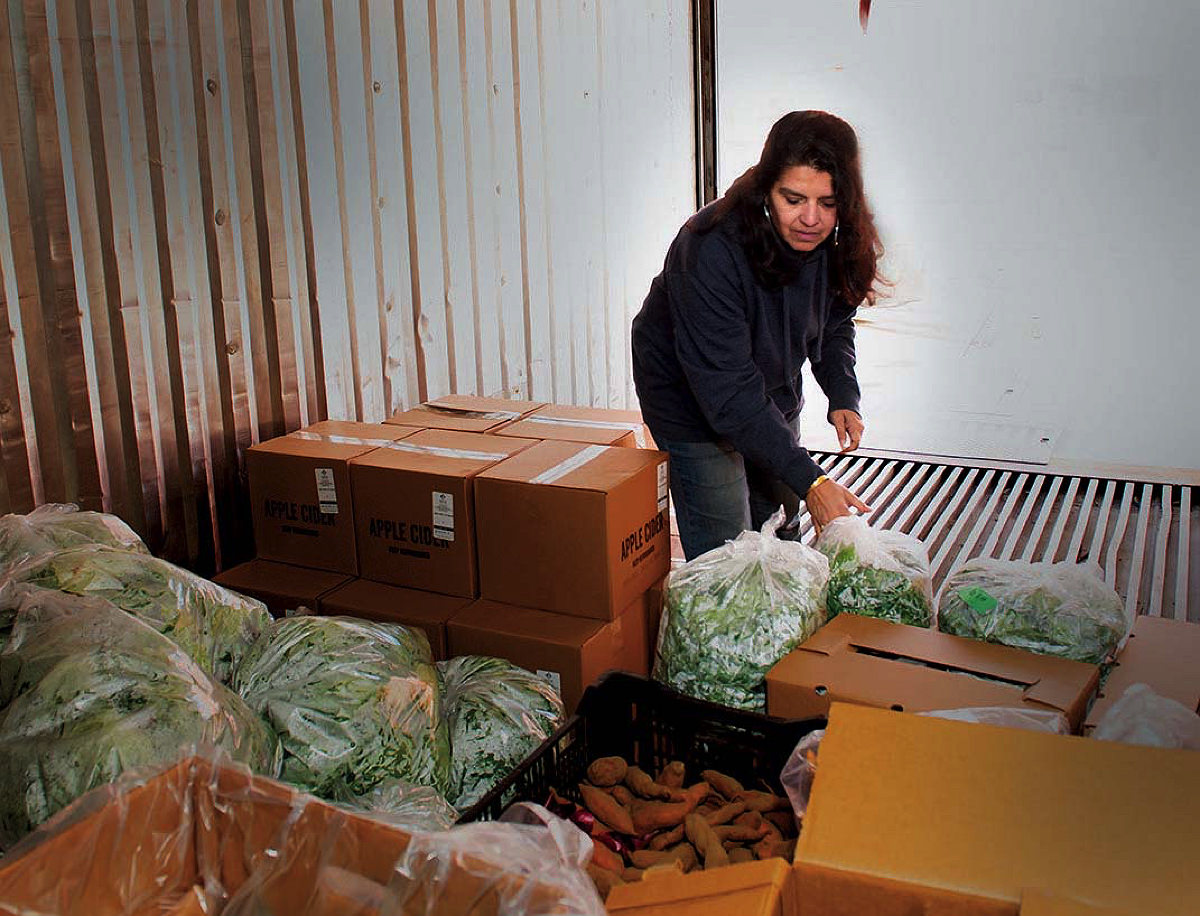
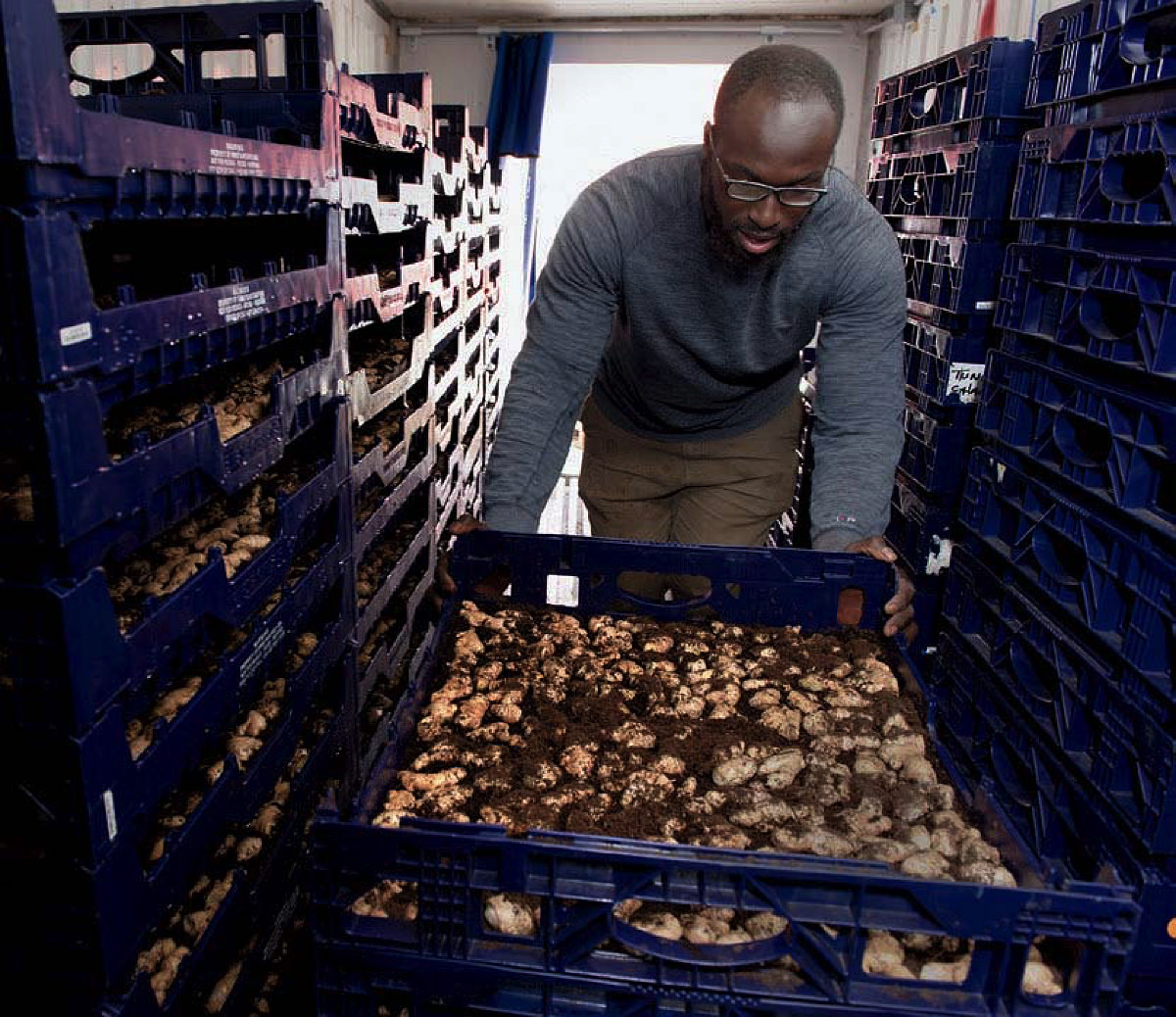
Thakrar sorting produce for distribution (top); farmer and driver Tim Offei-Addo organizing crates of ginger that he raised and donated
Photographs by Stu Rosner
These “kick loads,” as declined deliveries of produce are called, occur daily. The Gleaners and other local hunger-relief groups, like Lovin’ Spoonfuls and Daily Table, do what they can, but the surplus is overwhelming. “Because it takes infrastructure,” says Thakrar. “You have to take a tractor trailer whenever it shows up, have people to unpack as quickly as possible, and put all that food someplace cold—because very quickly you’re swimming in broccoli.” Untold tons of food—from perishable produce, baked goods, and prepared meals to expired canned, jarred, and frozen items—get tossed every day. U.S. Department of Agriculture data show that upwards of 30 percent of the food supply is wasted—even as 34 million people, according to Feeding America, face hunger. In Massachusetts alone, Project Bread surveys say, 16-18 percent of households experience food insecurity.
“The waste element drives me crazy, just because waste of any kind drives me crazy, but the kick loads drive me craziest,” says Thakrar, who left a career as a healthcare administrator, primarily at Dana-Farber Cancer Institute, to join the Gleaners in 2019. “Getting perfectly good food that is over here to the people who don’t have the food and need it over there seems like a solvable thing.”
When the organization was founded in 2004, by conservation-minded Oakes A. Plimpton, LL.B. ’60, it was a small, volunteer-run grassroots effort that harvested leftover crops at local farms and expired goods from his local Trader Joe’s. In the last three years, though, Thakrar and the team have expanded partnerships with farms and hunger-relief groups and tripled the Gleaners’ operations—to 23 full-time employees, a $3.5-million budget, and a fleet of 17 vehicles. In 2021, the organization also purchased the 51-acre Stonefield Farm, to start growing and disseminating its own produce. Last year, the organization distributed more than four million pounds of food through three primary sources: the farm, kick loads and crops gleaned at 53 partner farms, and Boston Food Hub (a newer wholesale program that buys produce from farms and sells it at cost to food-access organizations).
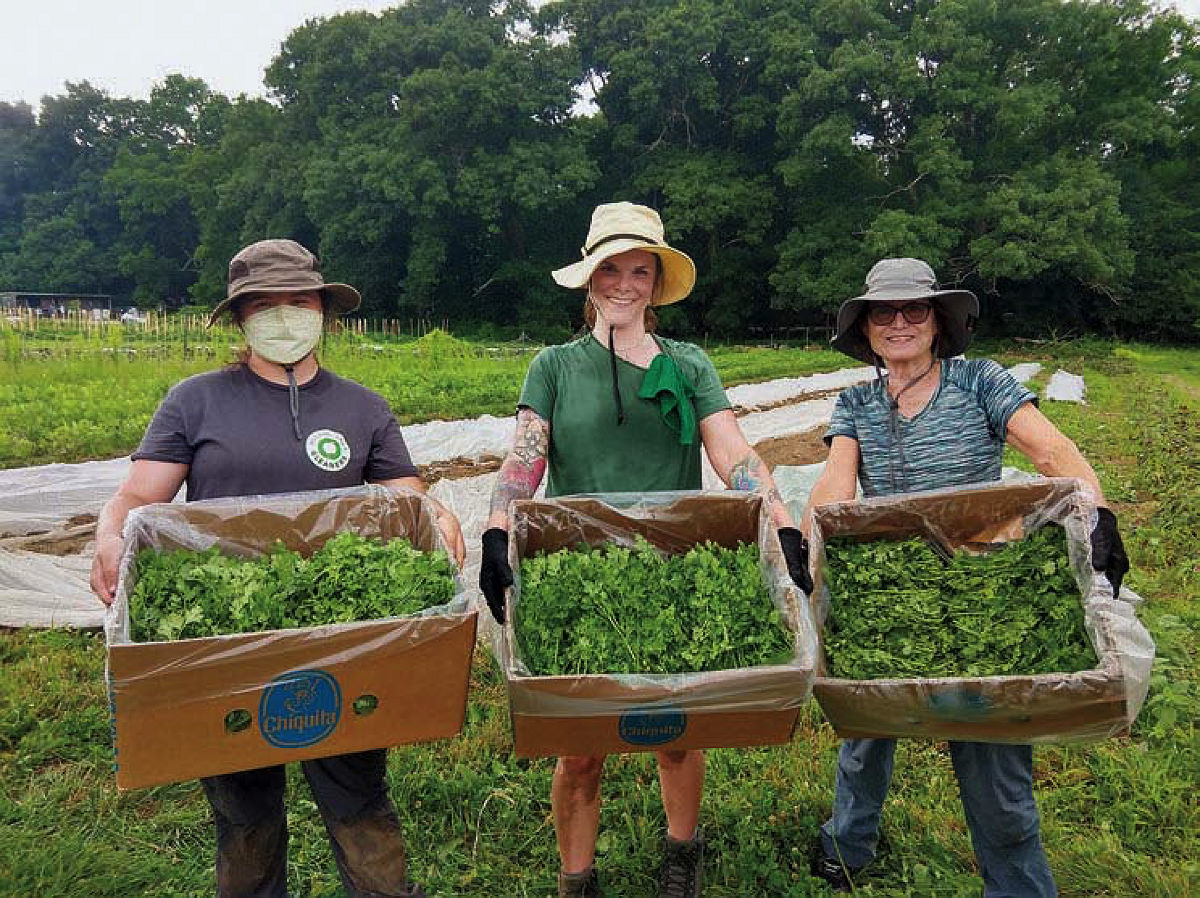
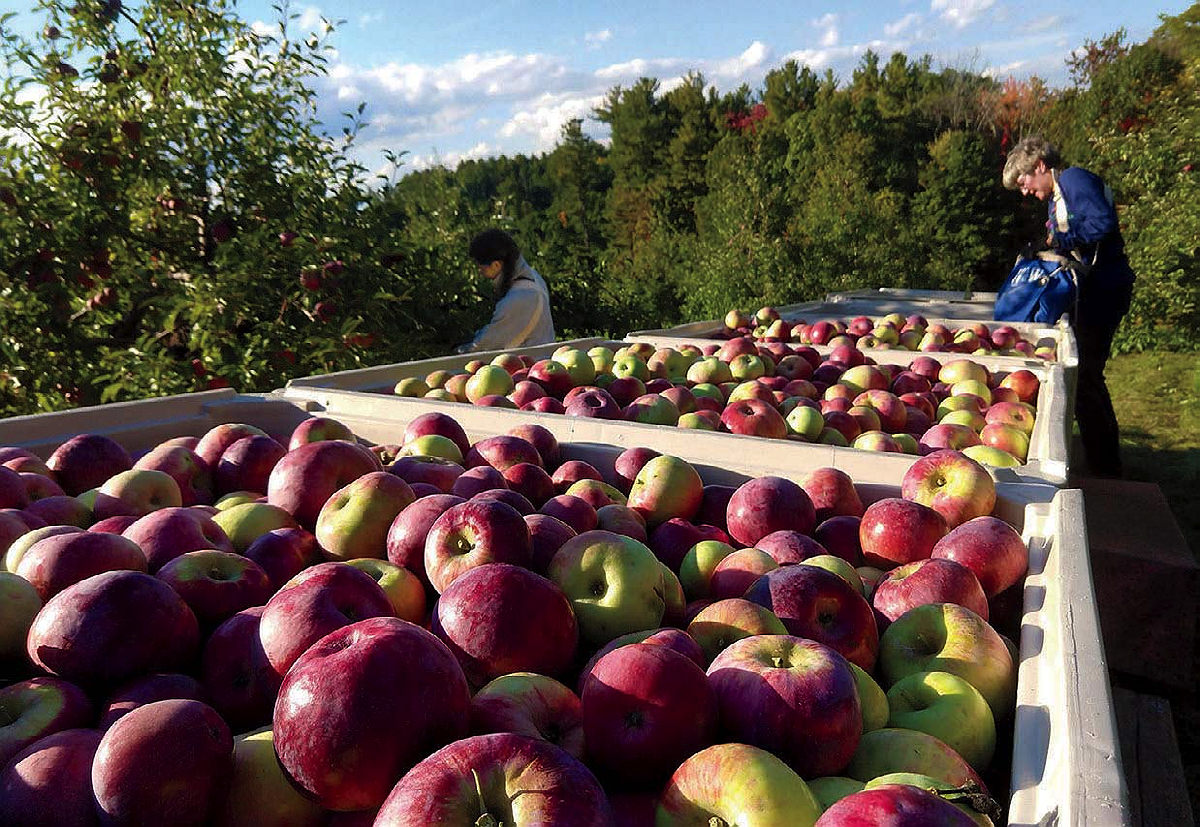
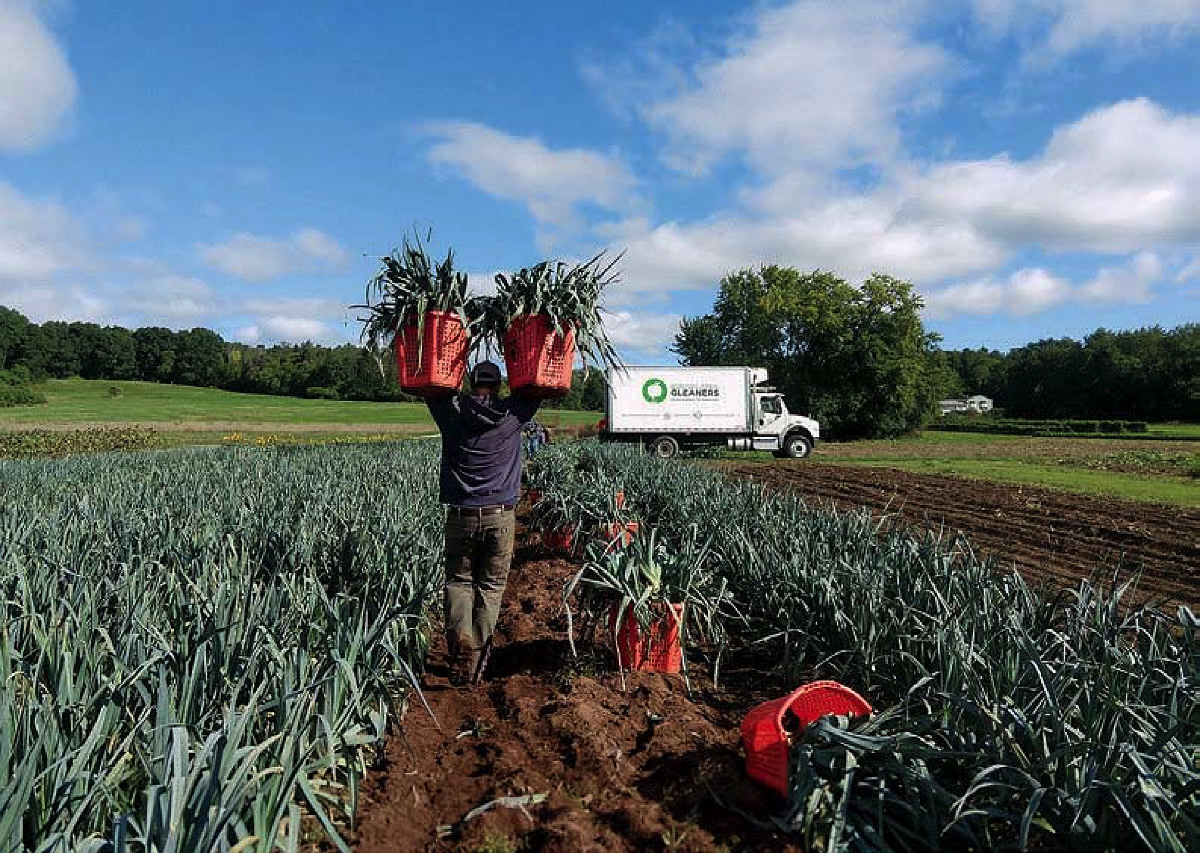
Staff and volunteers with gleaned and grown crops, including bins of locally grown apples
Photographs courtesy of the Boston Area Gleaners
What differentiates the Gleaners from other Massachusetts hunger-relief efforts is a focus on agriculture and fresh produce, Thakrar says, and its robust trucking, packing, and storing infrastructure. Her staff does not hand a head of lettuce to the consumer. It is, rather, a major aggregator: it gets fruit and vegetables from farms and other sources to the Greater Boston Food Bank and Food For Free, among others, and moves food from those entities to other distribution partners that lack trucking capacity. “Hunger in the United States is not a supply issue—it’s a logistical one,” she says. The processing and packing center at Stonefield Farm has a new trucking dock and four walk-in coolers. In the transition from Dana-Farber to the Gleaners, Thakrar traded dresses and heels for the jeans, sweatshirts, and work boots suited to days tromping around the farm. During harvest season, and 14-hour workdays, she holds meetings in the farm’s kitchen while cooking up a vat of pasta and homemade tomato sauce.
“Part of what I love about my work is the direct connection to food production—we aren’t dealing in boxed mac and cheese,” she says. “We are helping keep farms in business, which is a key factor in solving hunger.” The breakdown of supply chains during the pandemic clarified the need for locally sourced, nutritious food, she says, especially in communities where hunger and public health are intertwined. “That need always sticks with me. We are one of the richest countries in the world and one of the richest states, and yet one in six people can’t afford healthy food.” When visiting a Gleaners partner, a pandemic “pop-up” food pantry that still operates, she saw staff dole out numbered tickets in the morning for people who would return again in the afternoon to pick up their groceries. “Obviously, we need this type of emergency response. But something is very broken if this is the best that we can do for people.”
Health and medicine were central to Thakrar’s family life while growing up. She was born in England to Indian parents, but spent her first six years in Malawi, where they worked as physicians before settling in rural Georgia. “The people there did not really understand that people who were Indian might be from another part of the world, as opposed to Native American,” she says. “It was a pretty crappy 10 years during high school.” In her family, academic success was paramount, “and I, on my own, understood that that was my way out.” She chose to head north to Oberlin College, in Ohio, and then, after graduation, to Boston, where her sister, Nisha Thakrar, was in residency at Children’s Hospital (she is now chief medical officer at South Boston Community Health Center).
At Harvard Kennedy School in the mid-1990s, she studied public policy and health, completing a master’s degree project that explored why pregnant African American women with AIDS did not access services at a Boston clinic. She also met the man who became her husband, John G. Farr ’94, while working as a teaching assistant in one of his classes. Later, his years of cancer treatment at Dana-Farber led her to work there. She started as a volunteer and moved up to program administrator of the Perini Family Survivors’ Center and then clinical program director of pediatric oncology. At one point, Farr was an in-patient at the same time; he died in 2007, when their son, Kavi, was six.
As a single mother since then, she’s grown even more appreciative “that there are parents out there who have to make the impossible choice between things like heat and food, or not feeding themselves so their children can eat.” Hunger and waste infuriate her, even as she and her son have lived comfortably. “My father was an orphan in India, and his adoptive family was okay, and I grew up never wanting for anything,” she says. “But I recognize that that could have been very, very different.”
As her job at Dana-Farber became increasingly removed from patients and care, Thakrar spent her days “untangling bureaucratic messes” with insurance companies, regulatory agencies, and hospital administrators. “I could be on the phone with an insurance company, navigating with them because they told some scheduler that they could not schedule an MRI for some kid who had cancer—and even just saying that sentence does something to me,” she says now. “I was there several more years than I should have been for my own sanity.” When Kavi was a senior in high school, she took time off to figure out her next steps. Through volunteering at her local food pantry in Lexington, Massachusetts, since 2015, she began to explore how “people would show up with 20 cases of perfectly fresh produce,” she says, “and it was explained to me that it was all free. That’s how I learned about the Gleaners.”
Gleaning is an ancient practice, referenced in the Bible: “And when ye reap the harvest of your land, thou shalt not make clean riddance of the corners of thy field when thou reapest, neither shalt thou gather any gleaning of thy harvest: thou shalt leave them unto the poor, and to the stranger.” (Leviticus 23:22) At various times around the world, gleaning has also been exercised as a legal right. The Gleaners’ work depends on an army of some 600 volunteers who cull produce from fields and orchards from July through the first frost, with later-season gatherings of apples and root vegetables. Thakrar and colleagues have continued streamlining logistics, given the idiosyncratic nature of agricultural operations. A grower in Western Massachusetts with 70,000 pounds of extra carrots calls on a Tuesday and needs it gone by Friday so he can plow the fields for the next crop, she says. Another farm has 44,000 ears of fresh-picked corn it can’t store. The nonprofit mobilizes to harvest and fetch these kinds of loads, holding the food less than 24 hours. In season, the Gleaners get 20 such calls a week, and last August and September took in about 200,000 pounds of produce, with a banner pick in October of 16,000 pounds of squash in a day.
Last fall, Thakrar joined the Gleaners volunteers at the orchards of the Community Harvest Project in Harvard, Massachusetts. The nonprofit farm grows fruits and vegetables for hunger relief; each season the organization parks a trailer there for about three weeks, hauling thousands of apples as fast as volunteers can pick them.Of the 225,000 pounds of apples distributed in 2022, 70 percent came from that effort—and those apples lasted through well into this past February. Farm-food rescuing and kick loads last year yielded more than 1.2 million pounds of produce.
Field gleaning is still a primary activity, but Thakrar and the Gleaners’ director of operations and strategy Dylan Frazier, A.L.M. ’16, have refocused other programs and resources. The Boston Food Hub, for one, was a nascent operation that now functions as a direct nonprofit distributor for farmers who otherwise would not be able to access markets that it has forged. Similarly, Stonefield Farm, which historically produced tomatoes, is moving into cabbage and squash, along with okra, collard greens, and callaloo that “we know many minority communities tend to prefer,” she says. “The sexy word for it is ‘culturally appropriate’ produce.”
Philanthropic interest has dipped, “but the food need is still at pandemic-era levels”
But new challenges loom. “We are not seeing the same level of interest/philanthropy as a couple of years ago,” she says, “but the food need is still at pandemic-era levels.” The organization earns 37 percent of its annual budget; the rest of its funding comes from state and federal grants and foundations (46 percent), individual donors (14 percent), and corporate sponsors (two percent). Inflation, too, has been daunting—with the global financial outlook almost as unpredictable as the weather. The last two growing seasons—the wettest followed by the worst drought—reduced both the gleaning yield and Stonefield Farm’s production.
Thakrar knows that the Boston area emergency hunger-relief system is essential. But it’s clearly a Band-Aid for a far larger, chronic open wound. Food pantries are “not solving the root causes of why people have food insecurity in the first place,” she says, “and those causes are, of course, multifaceted and extremely complex, and I don’t even begin to think that I’m going to solve them or we as an organization can.” Last fall, the White House Conference on Food, Nutrition, and Health set a goal of ending hunger in the United States by 2030. But “what does that actually mean?” she asks. “That everyone can afford all the food they need? Or that everyone has access to a food bank or pantry? For me, ending hunger would mean everybody has access to affordable and healthy food that they need and want. But for that to happen by 2030?” Policy, she knows well from her Kennedy School degree and Dana-Farber experience, plays a crucial role in devising systemic change. “But that’s the long game,” she says. “I’m too impatient—I need to be doing the work on the ground.”







